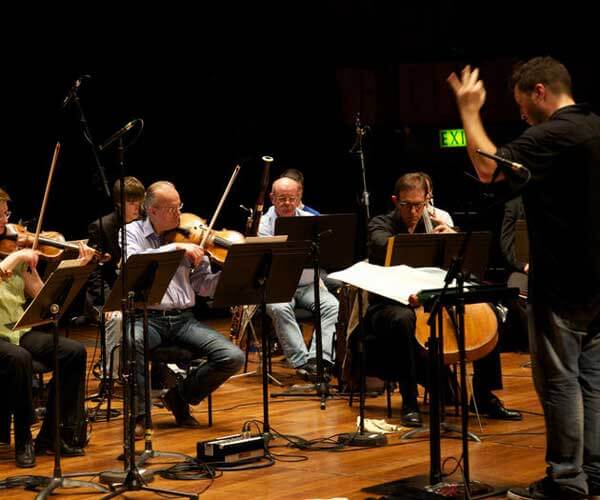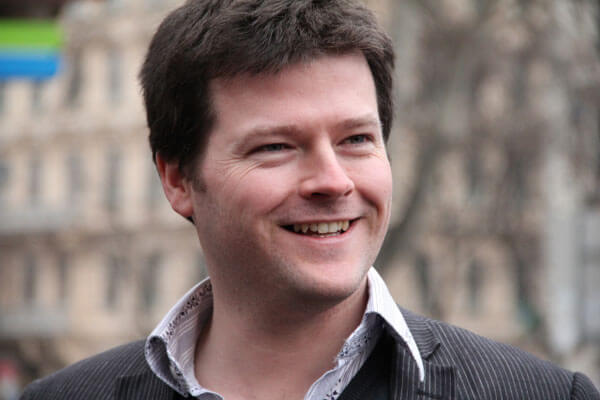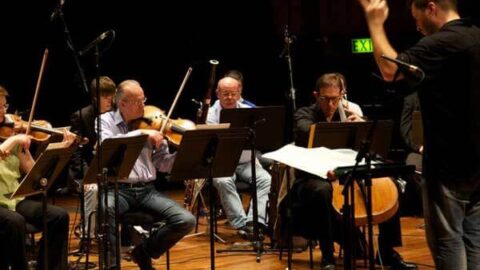 Situated on the edge of the River Thames, The Queen Elizabeth Hall at Southbank Centre was the site of New Music Show 3, presented by London Sinfonietta on Saturday, December 2, 2012. Standing in the main foyer before the performances began, it felt like being in a reverse greenhouse, looking out over the illuminated city lights and the winter market below as musicians graced the stage for the first time. The small space was packed with a jostling demographic: from suited business types occupying leather sofas to small children sitting opposite, falling asleep on their grandparent’s knees. A mere look around the room already indicated a degree of success in bringing contemporary classical music to a wide range of listeners, one of the Sinfonietta’s primary objectives.
Situated on the edge of the River Thames, The Queen Elizabeth Hall at Southbank Centre was the site of New Music Show 3, presented by London Sinfonietta on Saturday, December 2, 2012. Standing in the main foyer before the performances began, it felt like being in a reverse greenhouse, looking out over the illuminated city lights and the winter market below as musicians graced the stage for the first time. The small space was packed with a jostling demographic: from suited business types occupying leather sofas to small children sitting opposite, falling asleep on their grandparent’s knees. A mere look around the room already indicated a degree of success in bringing contemporary classical music to a wide range of listeners, one of the Sinfonietta’s primary objectives.

There was an extraordinary amount of music and atmosphere to take in over the course of the event, which was pitched by organizers as “a festival in a day” – from Toy Piano Suites to minimalist cello experiments, to an orchestral movement laced with atonal distortion and obscure vocal abrasions. The festivities that ensued made for a spectacular example of how rising talent is amplified through taking the compositional risks that London’s Sinfonietta purport to with the most honest intentions. The New Music Show series is about bringing contemporary classical to the fore, not only through allowing massive concession tickets, but also by bringing fresh works by youthful and unhailed performers such as Serafina Steer and emerging composers such as Tansy Davies and Andrew Hamilton.
Indeed, it was Hamilton’s recital of Product #1, which proved to be one of the most zestful and absorbing of the entire function. As part of the first set, it took place in the foyer, while hazy pinks and blues flickered behind in a wonderfully clear cityscape backdrop. The central hook proved to be the artist’s use of repetition, which was structurally deployed as a means of recreating the moments that led to the score’s incarnation. Hamilton was able to pull off an incredible performance in replicating what sounded like a distorted vinyl looping – one could almost identify the surface crackle in his violin strings, which fluttered and twitched as he continued to recycle previously played bars and lyrics alike. With no foreseeable end to the piece, the audience appeared completely caught up in its hypnotic indulgence.
The subsequent sessions took place either in the QEH proper, or in the Purcell room opposite, where Hamilton later discussed his work and the story behind it. He spoke almost immediately after his slot, on a panel with Larry Goves and Tansy Davies, whose works were performed shortly afterwards. It was interesting to hear Hamilton’s views on the repetitive devices used in Product #1. Davies was most dramatic in explaining her inspiration for Nature, where she envisaged the piano as a giant, black moth that scuttles about its setting, covered with leaves, deep within the overarching forest of the orchestra. The music turned out to be as haphazard as the composer’s description of it, where hurly burly tangents became ultimately tangled in the astute rhythmic density of the score’s chaotic makeup.
Nature might have been more penetrating had it not followed a swift, but breathtaking rendition of Hans Werner Henze’s Adagio Adagio, which was played as a dedication to the composer, who passed away in October, 2012. The piece embraced a melancholic air with a subtle and romantic bent for the instruments involved. Violin, cello and piano brought this remarkable fragment to life in a wholly gripping dedication that sounded spectacular despite the typically difficult QEH acoustics.

There followed a brief interlude, one of several gatherings exposing “intimate solo performances in hidden places” around the venue. These micro showcases were carried out by five composers in an insightful and unique approach to curation that brought an additional dimension to the engrossing on-stage discussions. Composer David Fennessy, speaking on the second panel, discussed the importance of industry in art and his fascination for the maintenance of privacy in populated environments, an intriguing insight into his work. The UK premiere of Fennessy’s 13 Factories, was immediately demanding and tense; the orchestra bled through the mechanical clunking of factory devices, bringing to mind the rumblings of 18th Century cotton mills. The four young individuals who stood behind the orchestra then lifted spherical speakers close to strategically positioned microphones in order to create high-pitched droning sequences. This punctuated the music, paving way for the trombone player and trumpeter to pour out their restrained vocal contributions, which brilliantly complimented the intertwining of orchestral output and pre-recorded samples.
Fennessy’s wonderful orchestration marked the concert’s centerpiece. Upon leaving the hall, it was all anybody seemed to be talking about, despite the gorgeous haphazardry of Gerald Barry’s Lisbon that ended the set. With one final hidden section to go, audience numbers began to dwindle before the late-night session kicked off. Billed as a Jarvis Cocker approved, harp playing, multi-instrumentalist, Serafina Steer’s slot was bookended by an experimental cello meditation by Alvin Lucier. It was an unfortunate addition to the bill that saw people leaving before the end of her set. Steer’s songs seemed so distant from everything else on the program that they would be much better suited to a folk bash of similar magnitude, as opposed to a classical one.
Odd fixtures aside, each concert embodied a remarkably enjoyable example of quality performance from one of London’s most compelling and daring orchestras. The pieces that were taken on for New Music Show 3 were challenging and thoughtful, a precise and refined selection of scores that not only explored unorthodox instrumentation, but also encouraged curious audiences to understand them through discussion and interaction. The combination of live productions, composer panels and responsive interludes made for an unrivaled introduction to contemporary classical for some, and a blissful reminder of the variance of its idiosyncrasies for others.
–
Daniel is a documentary filmmaker and writer currently residing in London. Follow him on Twitter: @danielemmerson.
























